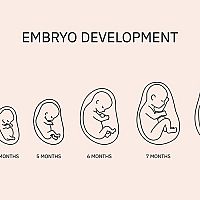
6th week of pregnancy - pain in the lower abdomen, symptoms, belly. Time for an ultrasound?
Step by step, week by week. The pregnancy is progressing. Some women are already fully experiencing morning sickness, others are beginning to perceive subtle symptoms, and there are also those who do not yet know they are pregnant. However, the 4th week from conception and 6 weeks from the last period means that bigger and bigger "miracles" are happening in a woman's body. The development of the embryo (baby) progresses and the foundations for the development of all the organs, systems and connections begin to form so that the nascent life can begin to function. It is during this period that you should inform your gynecologist about a possible pregnancy, and if you are lucky enough to have a free appointment, you will also have your first medical examination. What does a baby look like in the 6th week of pregnancy? What symptoms does a pregnant woman experience?
The woman is currently in the middle of the 2nd month of her pregnancy. The way to the desired baby in your arms is still quite long. The baby has already developed a simple heart that powers the circulatory system, and during an ultrasonographic examination you may even hear the heartbeat. The beginnings of pregnancy are very important, because a number of processes take place in a woman's body, which decide whether the pregnancy will be sustained. The symptoms of pregnancy are starting to become more pronounced in many women. However, it is also necessary to monitor possible complications. How does pregnancy develop in the 6th week?
6th week of pregnancy – baby's development and heartbeat
The embryo is currently around 3 to 6 mm in size. This is the equivalent of a grain of rice or lentils. From about the middle of the 6th week, it is possible to measure CRL values, although the shape of the embryo still does not resemble the human body. Some doctors record CRL values as early as the 8th tt. The fetus grows faster from week to week and the foundations for all important organs and systems in the body are formed. From a visual point of view, the head of the embryo develops the most, which has visible sockets for the ears, eyes and nose. In the lower part there is a so-called the tail, from which the spine will be formed.
The neural tube should close during this week so that the spinal cord and brain can develop. The basics of the locomotor system are also developing. Limbs begin to take shape very slowly this week. The same goes for some bones. The body of the embryo is already covered by a very thin skin. The sonographer in this phase can see only a small yolk sac in which the embryo flickers. During the examination, you may hear a surprising sound, which may be a heartbeat. It is still not a typical heart, but just a simple micro-heart, which has a beating frequency of approximately 110 to 150 beats per minute. It is also important that the umbilical cord connects to the placenta so that oxygenation and nutrition of the fetus can take place. For now, the circulatory system is connected to the chorionic villi on the wall of the uterus.
Other important bodies are also beginning to form. Kidneys, liver or lungs. The chest and ribs also begin to develop. This is a clear signal of the beginnings of the urinary, reproductive and digestive systems. During this period, the fetus is extremely susceptible to developing defects or genetic mutations. Therefore, it is important for a pregnant woman to avoid all harmful factors from alcohol and smoking to excessive stress.
What is CRL and how does it relate to baby development? You will also find this information in your pregnancy book, which you will receive after your first visit to the doctor. CRL is an abbreviation of the English words crown - rump - length. It is a measurement of the dimensions of the fetus from the top of the baby's head to the coccyx. This parameter is given in millimeters and is determined by the doctor regularly during every ultrasound examination until approximately the 20th-21st week of pregnancy. The CRL standards (embryo-fetal dimensions) are set for individual weeks, but these are indicative values, so there is no reason to panic if there are deviations. A difference of even two weeks is taken into account. This measurement is decisive from the point of view of determining the expected date of birth, possible problems in the growth of the fetus are detected, and also, if the woman is expecting more children, it can be observed whether the fetuses are developing at the same time.
First sono and visit to the gynecologist
From the 6th week of pregnancy, the topic is an examination at your gynecologist. If you have a pregnancy confirmed by a pregnancy test (note at least two positive pregnancy tests) and you have good reason to believe that you may be pregnant, book an appointment with your doctor. Most women visit a gynecologist around the 6th to 10th week of pregnancy. So don't worry if you can't get to the doctor in the 6th trimester. The exception is if you suspect certain complications.
When visiting a gynecologist, a group of examinations awaits you. The basis is the confirmation of pregnancy. In the 6th week of pregnancy, the doctor performs an ultrasonographic examination, which confirms so far only a biochemical pregnancy, which at this point becomes clinical. In early pregnancy, a vaginal probe through the vagina (vaginal ultrasound) is used to monitor the fetus. It is important that the embryo is implanted in the uterus and not in the fallopian tube or in another inappropriate space. This would be an ectopic pregnancy, which is unsustainable. It is also determined whether it is a multiple pregnancy. From this moment on, you will keep a pregnancy book. Furthermore, during the interview, the doctor will be interested in when you had your last period and approximately when fertilization occurred. The doctor will determine the date of birth, which will be specified in the following weeks.
The doctor will also be interested in your family history and your current state of health. The gynecologist will ask about what diseases you have overcome so far, what medicines you take, whether you have allergies or other health complications. Also what pregnancy symptoms you are experiencing. Complete laboratory tests, blood and urine sampling will be performed. A complete blood analysis is performed to determine the blood type and Rh factor (+/-), but also to detect the presence of various antibodies in the blood against certain diseases (syphilis, HIV, toxoplasmosis, rubella, chlamydia, jaundice or inflammatory diseases). The level of hormones in the blood is also investigated. They will measure your blood pressure and your height and weight. Any further examinations by a dentist, neurologist, internist or other specialist are determined by the gynecologist. At the same time, your doctor will arrange further meetings and examinations with you.

How to calculate the due date? It is important to say that the due date itself represents an indicative figure. You can calculate it simply by subtracting 3 months from the first day of your last period. You add 7 days to this number (the calculation applies to a 28-day cycle). Online calculators are also available for calculating the due date. However, your doctor will most accurately determine the date of your birth.
6th week of pregnancy - symptoms
A woman's body goes through a " hormonal storm " both physically and psychologically. However, all the processes that take place in your body have their meaning. Thanks to the emerging symptoms, you may fully realize that you are in the second state. Symptoms of pregnancy in the 6th week are very individual. Again, compared to the previous week, the manifestations may be more intense. Women still attribute many symptoms to premenstrual syndrome.
There is a feeling of an urgent need to urinate. More frequent urination is caused by a more blood-stained placenta, which presses on the bladder and at the same time the kidneys are more stressed. Morning sickness and fatigue are caused by sudden hormonal changes and an increase in blood volume in the body. Breasts are sensitive and larger. The nipples darken and begin to swell. Unpleasant heartburn may appear, which is typical for the first trimester. Typical symptoms are bloating, flatulence, constipation, hemorrhoids, headaches or even aversion to certain foods. You definitely won't notice a growing belly or movements in your belly yet.
A drinking regime, a balanced diet is very important, and walks or light exercise are also suitable. It is important to listen to your body. If you feel tired, give yourself a rest, don't stress. If it is sex in the 6th week of pregnancy, there is nothing to worry about, sex does not harm the course of pregnancy in any way. Blood flow to the pelvic area even increases libido - appetite for sex in some women.
Spotting and discharge in the 6th week
Women in the 6th week of pregnancy may experience discharge, spotting, or light bleeding. This is a normal phenomenon. The tissues of the uterus get blood, and occasional traces of blood do not mean any problem. The same applies to occasional pains in the lower abdomen. The reason is the stretching of the uterus and its growth. The tissues are stretched and cause occasional spasms. However, if the bleeding is more intense, lasts more than two days and is accompanied by strong cramps, increased temperature or diarrhea, visit your doctor immediately. It can be a miscarriage or an ectopic pregnancy.
6th week of pregnancy - experience
Pregnant discussants in discussions and forums often communicate the topic of possible complications during the 6th week of pregnancy. This is, for example, pain in the lower abdomen or cramps. Most women reassure the other discussants that it is an effect of the growth of the uterus and it is nothing serious. Of course, if it is not an intense pain accompanied by heavier bleeding. One of the discussants also dealt with the case that the doctor did not see an embryo in the uterus in the 6th trimester and the cavity (gestational sac) of the uterus was empty. The reason, according to the experience of other mothers, is that the fetus is still too small and cannot be identified by ultrasound. Therefore, it is recommended that potentially pregnant women wait for the first examination at least until the 8th trimester. A rising hCG value can also confirm pregnancy. At 6 weeks of pregnancy, it is already at the level of 1,080-56,500 mIU/ml.
The most frequent questions - FAQ
How did you experience or are you experiencing the 6th week of pregnancy? Did you experience any symptoms of pregnancy or did you have any symptoms in the 6th week of pregnancy? Have you already had your first ultrasound? Did you experience any complications or were you surprised by something? Share your experiences, opinions and stories with us and other readers. We will be happy if you join the discussion and with advice, observations and recommendations you can significantly help and advise other pregnant women - mothers-to-be. All you have to do is add your comment under the article. No registration is required.
Is it appropriate to go for a sonogram in the 6th week of pregnancy?
Can I be 6 weeks pregnant without symptoms?
Does the belly grow in the 6th week of pregnancy?
6th week of pregnancy, which month is it?
Gallery
Pridať komentár








